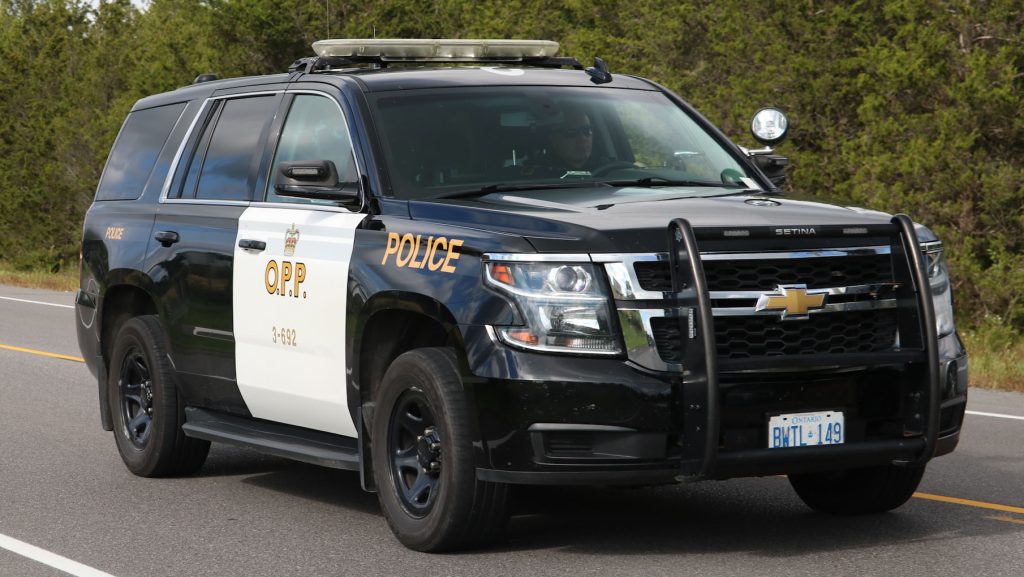Remember This? The Marian Congress
Posted Jun 13, 2022 01:27:00 PM.
CityNews, in partnership with the Historical Society of Ottawa, brings you this weekly feature by Director James Powell, highlighting a moment in Ottawa's history.
The Most Rev. Alexandre Vachon, the Archbishop of Ottawa, did not think small.
With the approach of the 100th anniversary of the founding of the diocese of Bytown (Ottawa) in 1847 by Bishop Joseph-Bruno Guigues, he wanted to celebrate the centenary in style. He also wanted the occasion to serve as a national, indeed international, opportunity to pray for lasting world peace. While World War II was over, global tensions were once again on the rise with the Cold War between the western Allies and the Soviet Union. The advent of atomic weapons and the ability of humankind to obliterate the world lent an additional degree of urgency to the plea for peace.
Devoted to Mary, the mother of Jesus Christ, the archbishop also wanted the ceremonies to be directed especially to the Blessed Virgin, asking her to intercede with God for the achievement of world peace and justice. With this in mind, Vachon travelled to Rome to get the support of Pope Pius XII. He probably didn’t need to do much convincing. The Pope was also a strong supporter of the veneration of the Virgin Mary. Three years later, he invoked papal infallibility to define as Church dogma the belief that Mary did not die but was rather taken body and soul into heaven—the Assumption of the Blessed Virgin. The three other dogmas related to Marianism (the veneration of Mary) are that Mary is the Mother of God, that she was born without original sin (the Immaculate Conception), and that she was a perpetual virgin, i.e., she was a virgin before, during, and after the birth of Christ.
The archbishop also toured European sites devoted to Mary to get a better understanding of how the Blessed Virgin was venerated at places such as Lourdes. He returned to Ottawa in February 1947, and immediately set to work organizing a Marian Congress, appointing two senior organizers—Monsignor Maxime Tessier and Monsignor John O’Neill—to put on the event. At the same time, Vachon announced the Congress to the world in a pastoral letter.
The Pope named James Cardinal McGuigan, the Archbishop of Toronto, legate a latere, the highest rank of papal representation, to the Congress. In other words, for the event, Cardinal McGuigan was the highest ranking Roman Catholic clergyman other than the Pope himself. In a message published in Ottawa newspapers, Cardinal McGuigan said that the Congress was the fulfillment of St. Luke’s prophesy regarding Mary being blessed among woman. According to the Cardinal, Mary “rescued woman from the contempt and degradation which it was her sad lot to experience under paganism.” Cardinal McGuigan was assisted in his duties by a Papal Mission that came to Ottawa for the Congress.
Six weeks prior to the official inauguration of the Marian Congress, a statue of Notre Dame du Cap (Our Lady of the Cape), was brought in stages from her sanctuary in Trois Rivières, Quebec, across 350 Catholic parishes in Quebec and Ontario to the Congress headquarters in Ottawa.
The shrine of Notre Dame du Cap marks the spot of two miracles attributed to Mary. The first was the miraculous building of an ice bridge in 1879 across the St. Lawrence River which enabled the transportation of stone across the river to build the church. The second occurred in 1888 when the statue of the Virgin in the church reportedly opened its eyes for ten minutes.
On arriving in Ottawa the evening before the official opening of the Congress, the statue was paraded through the streets of Lowertown led by the band of Lasalle Academy, followed by cadets of Notre Dame College. The Garde Champlain of Ottawa provided a guard of honour. A loudspeaker directed people in hymns and prayers. After passing through Lowertown, the parade made its way down the Driveway to Lansdowne Park. Along its path, thousands of people joined in. By the time the parade reached the Exhibition Grounds, the crowd had swollen to 40,000 people—too many to fit in the Coliseum for the official welcome. At the last moment, people were directed to the open-air stadium. As officials and police were unprepared for the huge crowd, there were some tense moments. At one point, a temporary steel scaffold was almost pushed over by the press of the crowd. The lights also temporarily went off when a cable became disconnected. Panic was averted when the reassuring voice of Archbishop Vachon calmed the crowd.
The main venue for the Marian Congress was Lansdowne Park. At the stadium, a Repository, (a place to hold the Blessed Sacrament) painted in blue and white—the colours of the Blessed Virgin—was constructed, 550 feet wide and 155 feet tall at the tower which was topped by a 27-foot statue of the Virgin Mary standing on a globe. The Repository had four stories with 30 confessionals on the ground floor and arcades higher up on which four fifteen-foot statutes of angels sounding bugles were positioned. On the top railing, written in three-foot letters, were the Latin words Ad Jesum Per Mariam, To Jesus through Mary—the theme of the Congress. Illuminated at night, the Repository could be seen for miles.
Inside the structure was an altar 155 feet wide, an oratory, vestries for officiating clergy, bathrooms, a room for the carillonneur, and accommodations for thirty-two workmen who lived on site, ready to get to work at a moment’s notice. There was also a large stage for theatrical performances. Behind the Repository were huts and tents for contractors, repair shops and storage for the thousands of props, including stacks of battle-axes and angel wings, to be used in the theatrical productions.
In front of the Repository was a massive open-air sanctuary with circular rows of seats, divided into sections, with a combined length of 5,300 feet. Each section was furnished with its own communion stand. Three rows of seats were reserved for the many cardinals and archbishops who were in attendance. Additional rows were reserved for members of the diplomatic corps, other Church dignitaries, and important lay guests and VIPs. During the masses held throughout the Congress, 500 priests aided by 500 altar boys provided the Holy Eucharist to the faithful that numbered as many as 75,000 at one time. Two thousand Boy Scouts directed people to their places.
For the Congress, the Exhibition Hall was converted into a Chapel of Peace where Notre Dame du Cap was installed. 30,000 votive candles burned on either side of the altar. Five other buildings at Lansdowne Park were filled with religious exhibits that displayed the many works of the Roman Catholic Church throughout the world. The display of Ottawa’s Grey Nuns of the Cross depicted the work they were doing among Canada’s Innuit peoples. The Horticultural Building housed the Congress communications—telegraph, radio and cable. Reportedly, press coverage of the Congress included 122 reporters and 94 photographers.
The Congress officially began at 2:30pm on 18 June 1947 when Cardinal McGuigan was driven from the residence of the Apostolic Delegation at 520, the Driveway, to the Basilica for the liturgical reception. Thousands of spectators lined the route. Many knelt in the street to pray and to receive the Cardinal’s blessing. After the formal reading of the Pontifical brief in both French and English, Archbishop Vachon gave a personal welcome address. Among the visiting cardinals were Francis Cardinal Spellman of New York and Cardinal Frings of Cologne, his home cathedral still in ruins from the Allied fire bombing of his city less than three years earlier. After the Pontifical High Mass, an address by the Pope was broadcast. 140 bishops knelt to receive the papal blessing; the largest number ever gathered in a Canadian church.
That evening, there was an official reception given by Archbishop Vachon and the Government of Canada in honour of Cardinal McGuigan, the Papal Legate. Prime Minister King, who was not Roman Catholic, emphasized the need to affirm “the fundamental principles of Christianity,” and that a new age had began with the release of atomic energy, one that could lead to “unprecedented progress or unparalleled destruction.” He contended that which route humanity took would depend on “whether the affairs of nations are to be based on a Christian or a pagan philosophy.”
The climax of the Congress came on the last day overseen by Cardinal McGuigan. At the celebratory mass, there were four Cardinals, scores of bishops, monsignori and canons, and thousands of priests, wearing their formal garb which, for the cardinals, meant lengthy red trains carried by pages. But the splendour of the Roman Catholic Church was almost upstaged by the arrival of the Dionne quintuplets: Cécile, Annette, Yvonne, Marie and Émilie. Dressed identically in white dresses with little white hats, the girls, who had just turned thirteen, arrived at the Repository in a motorcade to sing Laudate Maria. To the disappointment of the crowd, after their performance, the girls were whisked away in the middle of a sermon given by Cardinal Gerlier of France. The cardinal couldn’t have been too pleased as six cars and motorcycle policemen roared in front of him as he spoke to pick up the quints and other members of their family.
Later that night, notwithstanding frequent rain showers, a lavish tribute to the Virgin Mary written by Rev. Gustave Lamarche, entitled “Our Lady of the Crown,” was performed in French in front of an audience of more than 50,000. In the play, Mary is saddened by the selfishness of mankind. At one point, on a large screen, the world could be seen spinning in space amidst a barrage of bursting shells and soldiers charging with fixed bayonets, with the devil hovering over all. Finally, the world is obliterated by atomic bombs. Three ballets were also performed. In the Ballet of Flowers, florescent petals showered down, illuminated by ultraviolet lights. A shepherd offers a real lamb to Mary. During the Dove Ballet, in which dancers were costumed as white doves, hundreds of pigeons were released into the air. In the Ballet of Stars, the moon was brought down from the heavens as a gift for Mary. Finally, a troubadour entered on horseback and mounted the steps to Mary’s throne through an archway of crossed halberds carried by a bodyguard. The troubadour offered the Blessed Virgin the gift of the arts.
Through the Congress period, other performances were held, both in English and French, both at the Repository and elsewhere. At the Capitol Theatre, it was standing room only for repeated performances of “Our Lady of Fair Love.” This was a passion play telling the story of Christ’s last hours from his betrayal by Judas, to his crucifixion and subsequent resurrection. Among the lighting effects used in the show, a tableau of the Last Supper as painted by Leonardo da Vinci was created.
Two parades were also held through the city. Thirty floats depicting the life of the Virgin Mary were drawn through Ottawa. Starting at Wellington and Lyon Streets, the floats, along with the RCMP band and troops of Boy Scouts and Girl Guides, wended their way to Confederation Square, then along the Driveway to Lansdowne Park. Later, a similar parade was held at night by candlelight. At this one, McGuigan, the Cardinal Legate, carried the Blessed Sacrament. He was accompanied by bands, battalions of parochial guards and Papal Zouaves in full costume, floats, and 600 maids of honour dressed in costumes. Church officials, members of Parliament, judges and other civil officials also marched in the parade down the Driveway to the Repository.
But the big spectacle was a pageant called “Our Lady of the Bread” held at the Repository. On a two-level stage, two thousand Ottawa-area performers backed by the Montreal Symphony Orchestra and two choirs put on a show that was unlikely to be forgotten by any in attendance. The show had seven scenes, opening with angels and priests begging Mary to distribute the Bread of Life. This was followed by an appearance of the Blessed Virgin in front of a giant, 50-foot stained-glass window. Scene three had Mary giving the Bread of Life to the seraphines, while in scene four Mary accepts the invitation of the Church to distribute the Bread to the faithful. Messengers are then requested to invite the faithful to the banquet; priests are first to accept. Scene six is the response of humanity to this invitation, while the closing scene paid a final tribute to Mary as Queen of the Sacred Bread with her showing the world the Host of Salvation amidst an orchestral and choir crescendo. Tickets for the performances ranged from fifty cents to three dollars.
That night, a massive, fireworks display lasting more than 40 minutes lit up the sky above the Exhibition Grounds. The piece de resistance was a blazing outline of the Virgin Mary ascending into Heaven.
The Marian Congress was a huge success, attracting more than 250,000 pilgrims. For five days, Ottawa was the centre of the Roman Catholic Church in North America. The city, bedecked with flags, was chock-a-block full. Hotels were full to bursting as were private homes. Even the parks were clogged with campers. To fill hungry tummies, eight hundred servers working for the Morrison-Lamothe bakery at the Exhibition Grounds, served 500,000 people over the five-day period, selling 15 tons of hot dogs, three tons of ham, one ton of cheese, one ton of coffee, half a ton of tea, 100,000 chocolate bars, 200,000 ice creams, 125,000 doughnuts, and one million soft drinks.
To get a better sense of the scale and grandeur of the Marian Congress, here is a link to a short video of the event: The Marian Congress, Ottawa June 1947.








